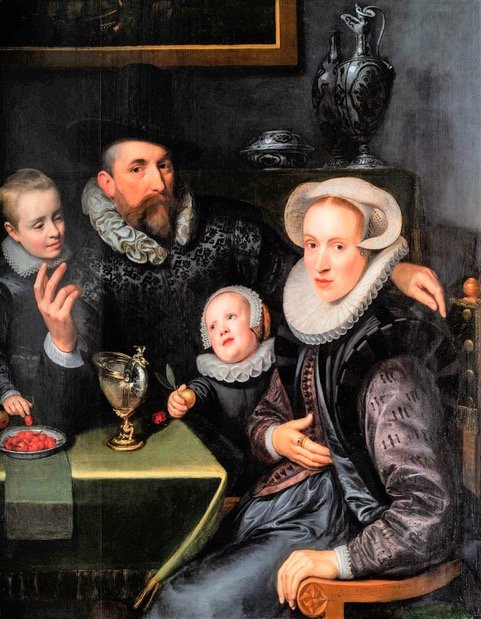ANONYMOUS MASTER THOUGHT TO BE FROM DELFT, 1608
Portrait of a Family Seated at a Table
inscribed and dated on the armrest of the chair in the lower right: AETATIS 27 Ao 1608
oil on panel
46 x 40.5 inches ( (117 x 103 cm.)
PROVENANCE
August Baron von Miller zu Aichholz, Vienna, circa 1890
Baron Heinrich Thyssen Bornemisza, Schloss Rohoncz, Rechnitz, Austria by 1930 and Lugano, Switzerland by 1939 (as by Cornelis de Vos)
Kunsthandel P. de Boer, Amsterdam, 1958 – 1959, from whom acquired by
Private Collection, The Netherlands until the present time
EXHIBITED
Munich, Neue Pinakothek, Sammlung Schloss Rohoncz, 1930, no. 345 (as by Cornelis de Vos)
LITERATURE
Fritz Dörnhoffer, “Cornelis de Vos, Familienbildnis” in Sammlung Schloss Rohoncz, Neue Pinakothek, Munich, 1930, p. 100, no. 345
Edith Greindl, “Cornelis de Vos” in U. Thieme & F. Becker, Allgemeines Lexicon der Bildenden Künstler von der Antike bis zur Gegenwart, volume 34, Leipzig, 1940, p. 532 (collection Baron Thyssen, Lugano)
Edith Greindl, Corneille de Vos: Portraitiste Flamand (1584 – 1651), Brussels, 1944, pp. 55-56, 146, plate 55 (as by Cornelis de Vos)
Exhibition Catalog, Kunshandel P. de Boer, Amsterdam, 1958, unpaginated, illustrated, (as by the Haarlem Master of 1608)
Exhibition Catalog, Kunsthandel P. de Boer, Amsterdam, 1959, unpaginated, illustrated (as by Cornelis Engelsz Verspronck)
Rudi Ekkart, Johannes Cornelisz Verspronck . Leven en werken van een Haarlems portretschilder uit de 17de eeuw, Frans Hals Museum, Haarlem, 1979, pp. 25-26, fn. 11 (stating an attribution to Cornelis Engelsz should be considered)
Rudi Ekkart, “Delftse portrettisten 1550 – 1650” in De Portretfabriek van Michiel van Mierevelt (1566 – 1641), Museum Het Prinsenhof, Delft, 2011, p. 18, fig 9, illustrated (as an Anonymous Master)
“Curator’s lecture by Jan van Campen: ‘Asian art and the depiction of wealth and success’” The Royal Asian Art Society in The Netherlands at The Rijksmuseum, on kvvak.nl, illustrated (as by Michiel van Mierevelt)
A family group is depicted in their home, the year is 1608. The mother is 27, the husband slightly older. Symbolic of love, a little girl clutches a pear, while looking adoringly at her older brother who returns her gaze. The bowl of cherries, as well as the sprig held by the boy and pair near the little girl, symbolize a wish for fruitfulness in their futures, and were attributes often found in Dutch children’s portraits of the seventeenth century. The room is richly appointed with a stunning nautilus cup prominently positioned on the table covered by a velvet cloth, with large pieces of Delftware displayed on the similarly covered cupboard along the back wall just beneath the lower edge of a substantial painting. Seated in a Spanish leather chair, the mother is very fashionably attired in a winged cap, white ruff, and satin dress with a sleeveless jacket ornamented with shoulder-wheels. Equally stylish is the father’s split ruff collar, intricately embroidered jacket and tall hat.
The painting is an obvious portrayal of wealth, but even more so of familial love. It is exceedingly rare to have these emotions on display in such an early portrait of a family group. The gestures of the right hands of both husband and wife serve to usher the viewer into the scene, while the casual intimacy of the husband’s draped arm around his wife is almost shocking.
Although a conclusive attribution to the painter of this masterwork has never been determined, the consensus is “an artist who must have been one of the leading portraitists in Delft in the seventeenth century”.[1] As so much was lost over the centuries sometimes outstanding pieces stand alone. It was always regarded as a treasure by the collectors who owned it: August Baron von Miller zu Aichholz, Baron Heinrich Thyssen Bornemisza, and Kunsthandel P. de Boer who sold it about 1959 to the important Dutch collection in which it currently resides.
[1] See Rudi Ekkart & Claire van den Donck, “Portrait of a Family Seated at a Table, 1608”, Doek Art, May 25, 2021.
